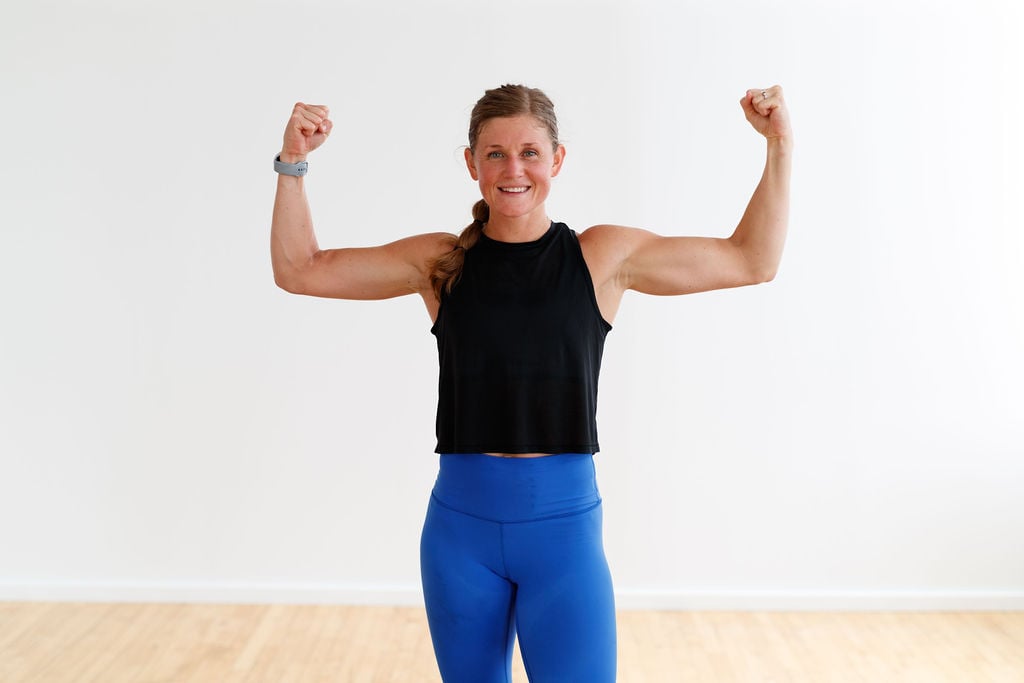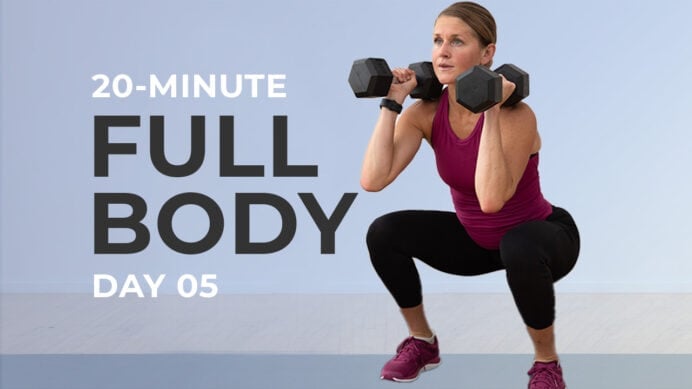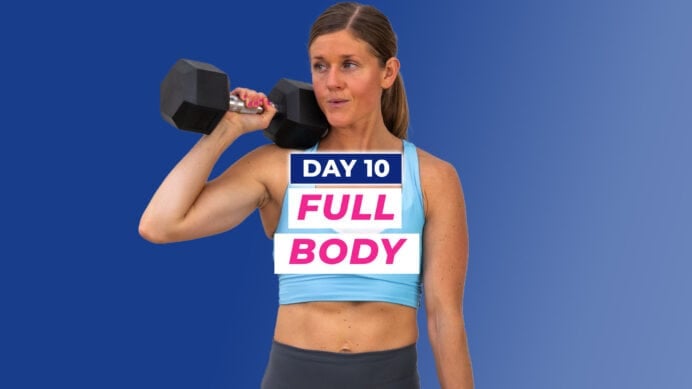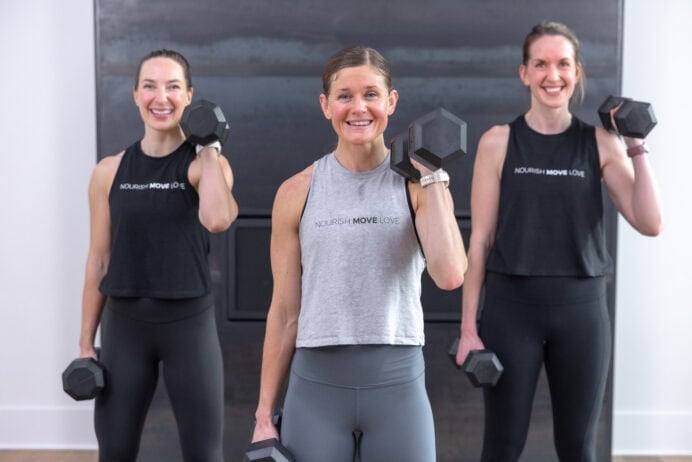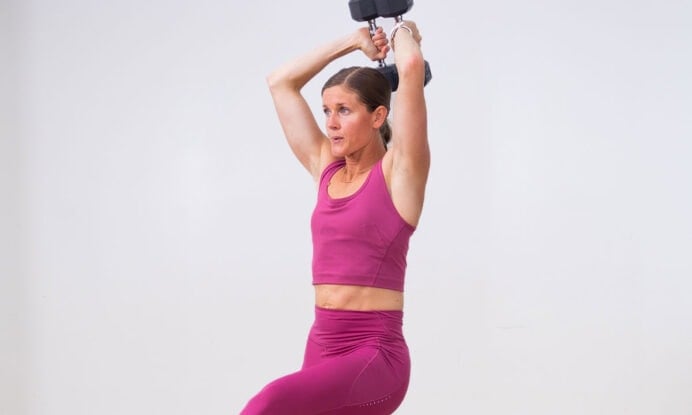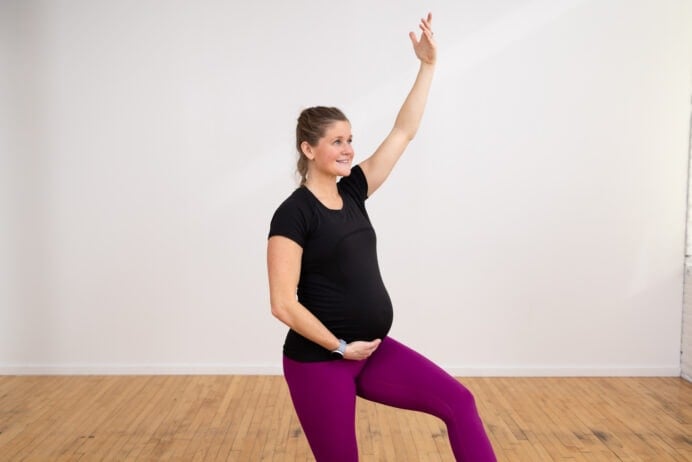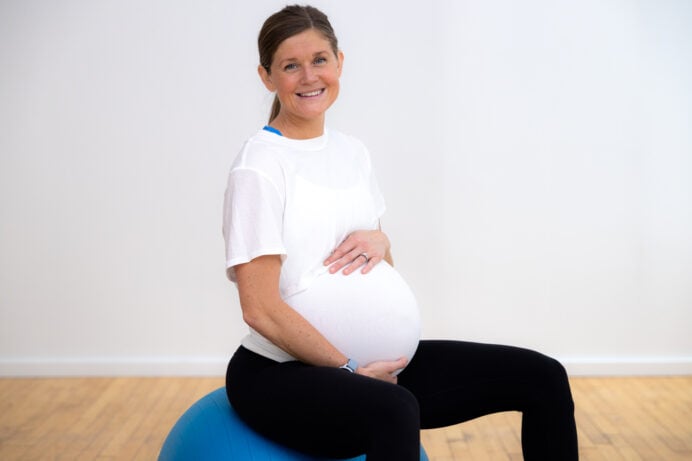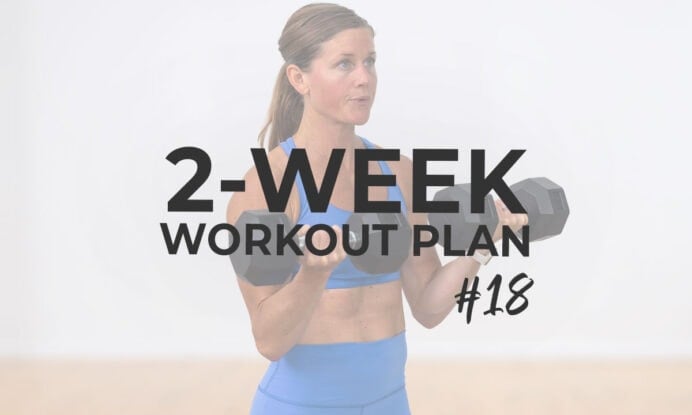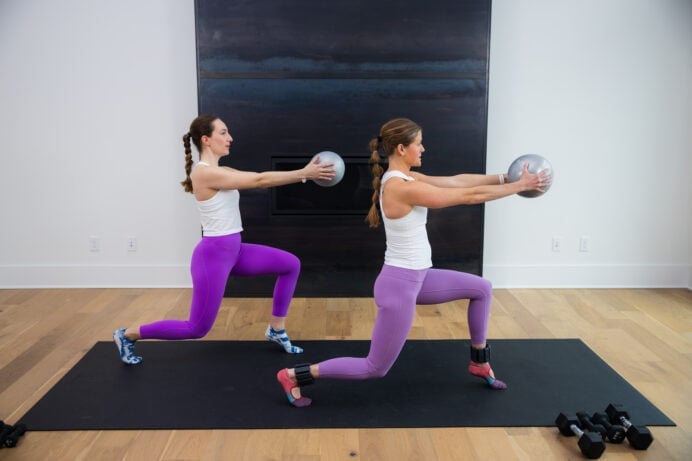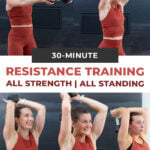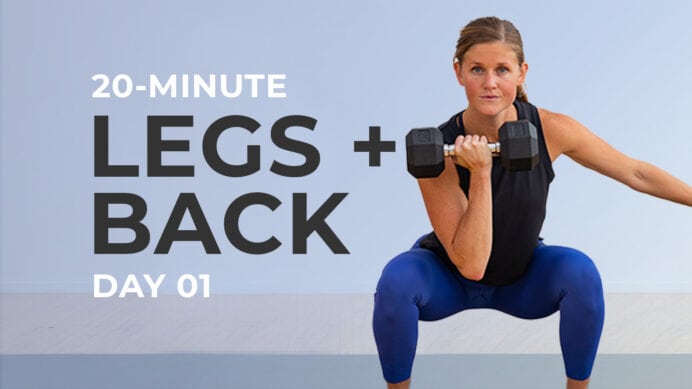
7 Resistance Training Exercises At Home
Build total body strength without a trip to the gym! Get an effective, full-body workout using just a pair of dumbbells with these resistance training exercises at home – no floor work required. I recommend this low-impact, all-standing and all-strength workout for all fitness levels.
This post is brought to you in partnership with the Minnesota Pork Board.
Whether you’re short on space, tight on time, or simply prefer to remain standing during your workouts, this at-home resistance training routine targets all the major muscle groups while improving balance and stability.
As someone who has been in the fitness world for most of my life (spanning everything from competing as a college athlete, to running marathons to teaching barre classes), I’ve gone through many different “fitness phases” where I prioritized different training goals.
Through it all, there’s one type of workout I’ve always come back to: resistance training.
Resistance training (also called weight training or strength training) is any movement that requires moving your body against a form of resistance. It’s also one of the most effective workouts you can do; and is shown to support healthy weight management, improve metabolism and reduce risk of cardiovascular disease (Mayo Clinic).
In my opinion, the best resistance training exercises at home are both simple and scalable. That makes them accessible to all fitness levels and encourages progressive overload (or increasing the difficulty over time to prevent fitness plateaus).
There are multiple different types of resistance you can use to build strength:
- Bodyweight: bodyweight strength training is the most accessible form of resistance training, since it requires no additional equipment. Popular examples include push-ups, squats, lunges and planks.
- Resistance Bands: resistance bands are affordable, versatile and a great way to increase the intensity of bodyweight exercises. I personally love resistance band workouts when I’m traveling.
- Free Weights: in my opinion, free weights (such as dumbbells or kettlebells) are the most effective way to add resistance to your workouts. This is because dumbbell strength training exercises increase core stability and prioritize more functional movements than gym machines.
- Resistance Machines: if you’re following a gym workout routine, you’ll likely use a mix of cable machines and single-exercise machines (such as the chest press, leg press, or lat pulldown machines) for resistance training.
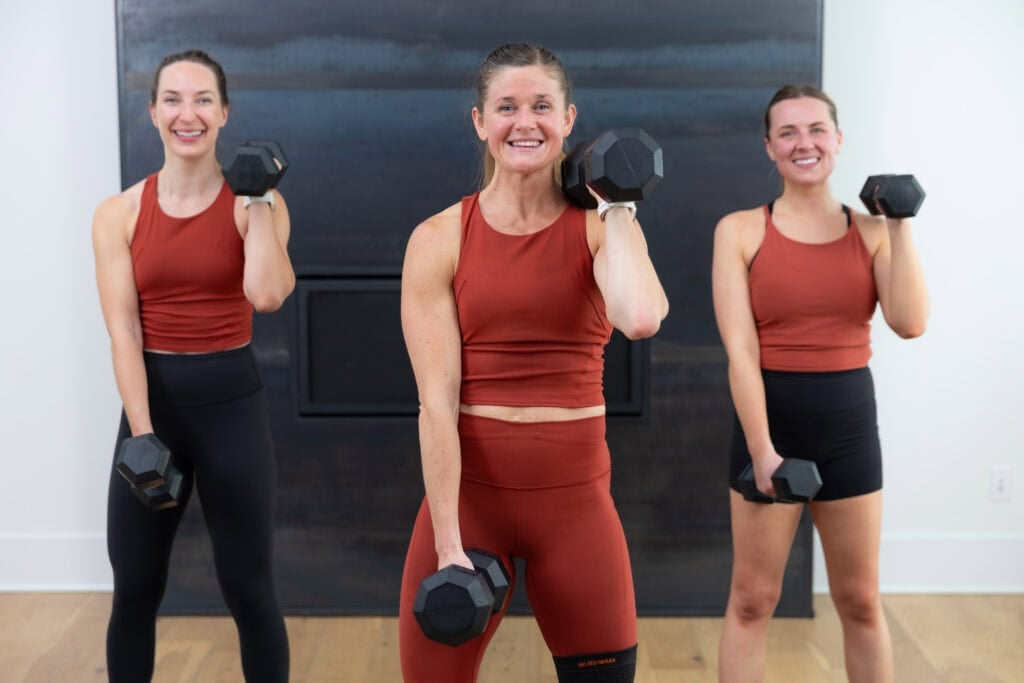
Workout Overview
This full-body workout combines 7 of the best resistance training exercises at home to build functional strength in just 30 minutes. This weight lifting workout also includes a dynamic warm-up and a comprehensive cool-down.
Add full-body strength training workouts like this to your home workout plan one to two times a week to increase muscle definition and strength in the upper body, lower body and core.
Workout Instructions:
Follow along with the guided Resistance Training Workout on YouTube, led by me — your certified personal trainer, Lindsey Bomgren.
Your Workout Looks Like This:
- 7 Resistance Training Exercises at Home
- Timed Intervals (40 seconds of work, followed by 20 seconds of rest)
- Repeat All 7 Exercises x 3 Sets
Workout Equipment:
Medium to Heavy Set of Dumbbells. I recommend between 5-30 lbs, depending on your fitness level. I’m using 15-30 lb dumbbells in today’s workout.
Workout Outline
1. Dumbbell Squat and Hammer Curl
Targets: glutes, quads, hamstrings, biceps, back and shoulders.
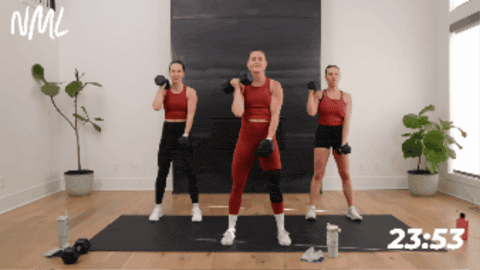
How to Do a Dumbbell Squat and Hammer Curl
- Start standing, feet shoulder-width apart and knees slightly bent.
- Hold one dumbbell in your left hand between your legs. Hold another dumbbell in your right hand in a front-rack position at your right shoulder.
- With your weight in your heels, sit your hips back as you lower into a squat, striving for a 90-degree angle between your hips and knees.
- Then, drive through your heels, squeezing your glutes to stand tall.
- Curl the dumbbell in your left hand up towards your left shoulder as you simultaneously lower the dumbbell at your right shoulder between your legs.
- Repeat, alternating one uneven squat with one bicep curl.
2. Staggered Deadlift and Back Row
Targets: legs, hamstrings, glutes, hips, lower back, mid-back, arms, biceps, shoulders, abs and core.
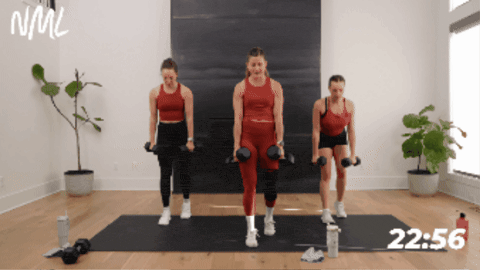
How to Do a Staggered Deadlift and Back Row
- Start standing with feet hip-width apart, knees slightly bent. Stagger your feet, so your left foot is slightly in front of your right. Keep 80% of your weight in your left foot, and 20% in your right toes.
- Hold a dumbbell in each hand, palms facing in towards each other (narrow grip).
- Hinge at your hips to lower the dumbbells down towards the ground, keeping your hips square to the mat. Lower the dumbbell until you feel a stretch in your left hamstring (back of your leg). Range of motion looks different for everyone.
- Hold this staggered deadlift position, then perform two single arm back rows; pulling first your right elbow to your right hip before lowering with control, then your left elbow back to your left hip before lowering the dumbbell with control, returning to the bottom of the staggered deadlift position.
- Finally, perform a narrow dumbbell back row, pulling both elbows back towards your hips and squeezing your shoulder blades together before lowering with control.
- Press through your heels to stand tall, returning to the starting position.
3. Split Lunge
Targets: legs, glutes, quads, hamstrings and core.
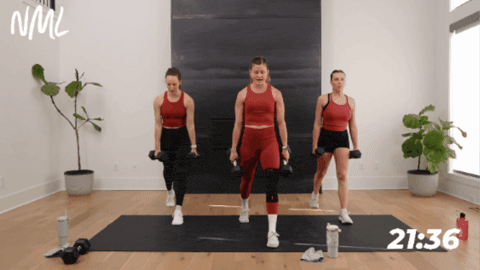
How to Do a Split Lunge
- Start standing with feet hip-width apart holding one dumbbell in each hand at your sides.
- Step your right leg back into a lunge position. Imagine your feet are on train tracks – front left foot planted on the mat and back right toes on the mat. Feet stay planted in this position throughout the entire movement.
- Lower your right knee towards the mat until your front thigh is parallel to the mat. Both knees bent at 90 degrees. Shoulders remain stacked over hips.
- Then drive up through your front heel to stand tall, returning to the top of the movement.
4. Dumbbell Front Raise and Svend Press
Targets: chest, shoulders and upper back; specifically the front and middle heads of the deltoids (shoulders), as well as pectoral muscles/pecs (chest), the trapezius and rhomboids (back).
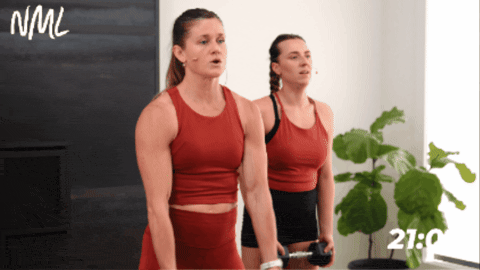
How to Do a Dumbbell Front Raise and Svend Press
- Start standing, feet hip-width apart, slight bend in your knees. Hold one dumbbell horizontally between your hands in front of your body at your hips.
- Tuck your tailbone to engage your core, then keep your arms relatively straight while raising the dumbbell out in front of you, lifting the weight just to shoulder-height. Keep a soft bend in your elbows.
- Then, keep your shoulder blades back and down as you pull the weight in towards your chest, elbows falling back towards your ribs.
- Exhale as you press the weight straight out, thinking about squeezing your hands in towards each other to activate your chest muscles (this is a Svend press).
- With control, keep your arms straight as you lower the dumbbell to your hips, returning to the starting position.
5. Lateral Lunge
Targets: legs, glutes, quads, outer thighs and glutes (gluteus medius and abductors) and inner thighs.
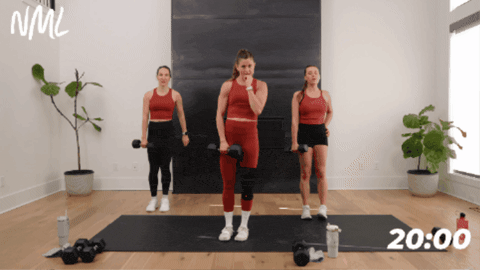
How to Do a Lateral Lunge
- Start standing, feet hip-width apart holding one dumbbell in your left hand in front of your left thigh.
- Take a large step to the right with your right leg as you sit your hips back, bending your right knee while leaving your left leg straight. Think of performing a single leg squat with your right leg while your left leg remains straight, knees and toes pointing forward. Aim to lower the dumbbell towards your right ankle.
- Then, drive off your right foot to reverse the movement, pulling your inner thighs together as you stand tall, returning to the starting position.
6. Overhead Tricep Extension
Targets: the long head of the triceps and all the stabilizing muscles in the shoulders, core, glutes and lower back muscles.
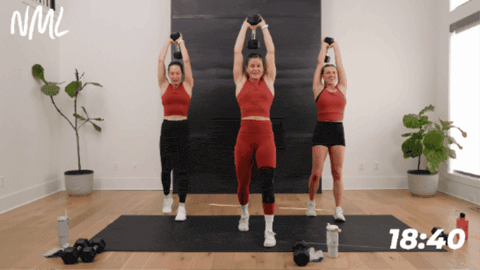
How to Do a Overhead Tricep Extension
- Stand with feet hip-distance apart, core engaged and a soft bend in your knees.
- Hold one dumbbell vertically overhead and activate your core by squeezing your glutes and abs to protect your lower back.
- Bend your elbows to a 90-degree angle, bringing the dumbbell behind your head. Think ‘hide the dumbbell, show the dumbbell’ if you were watching yourself in a mirror. Keep your elbows close to your ears throughout the entire movement (don’t let your elbows flare out as you fatigue).
Modification: if pressing the overhead press portion of this exercise isn’t comfortable for your shoulders, you may substitute standing tricep kickbacks.
7. Squat with Rotational Press
Targets: glutes, quads, hamstrings, shoulders, upper back and core.
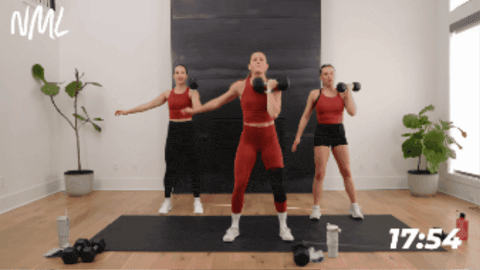
How to Do a Squat with Rotational Press
- Start standing with your feet shoulder-width apart and core engaged. Hold a dumbbell in your right hand at your right shoulder, palm facing in towards your body.
- With your weight in your heels, sit your hips back as you lower into a squat, striving for a 90-degree angle between your hips and knees.
- Then, drive through your heels, squeezing your glutes to stand tall. As you stand, keep your left foot planted while pivoting your right toes, hips and shoulders to the left. Use the power from your lower body to press the dumbbell overhead, extending your right arm to stack the weight above your right shoulder.
- Slowly return to the starting position by reversing the movement; returning the dumbbell to your right shoulder and pivoting so your toes, hips and shoulders are facing forward, returning to the starting position.
FAQs
You can gain all the health benefits of strength training from just 2-3 sessions a week. If you’re a beginner or working out fewer than 3 days a week, I recommend focusing on full-body workouts: this allows you to hit each muscle group multiple times during the week, which is necessary for building muscle mass and seeing muscle growth. My beginner workout plan includes options for 3-day, 4-day and 5-day workout splits.
Resistance training helps build lean muscle, which boosts your metabolism and helps your body burn more calories (even after your workout ends). If your goal is to lose weight and increase muscle tone, a combination of strength training workouts (to increase muscle definition) and eating in a calorie-deficit (to lose weight) is extremely effective.
Squats, pull-ups, push-ups, bent-over rows, chest presses, and glute bridges/hip thrusts are some of the best at-home resistance training exercises. These exercises can be performed with just your body weight, dumbbells or resistance bands.
Lifting weights will not make you bulky, but it will help you achieve strong, toned muscles. The truth is that bulking is difficult, and building bulky muscles requires extra calories, genetics and a really intentional and consistent muscle-building routine. You won’t get bulky from doing workout routines like this one.
More Workouts
Strength WorkoutsPin This Full Body Strength Training Routine
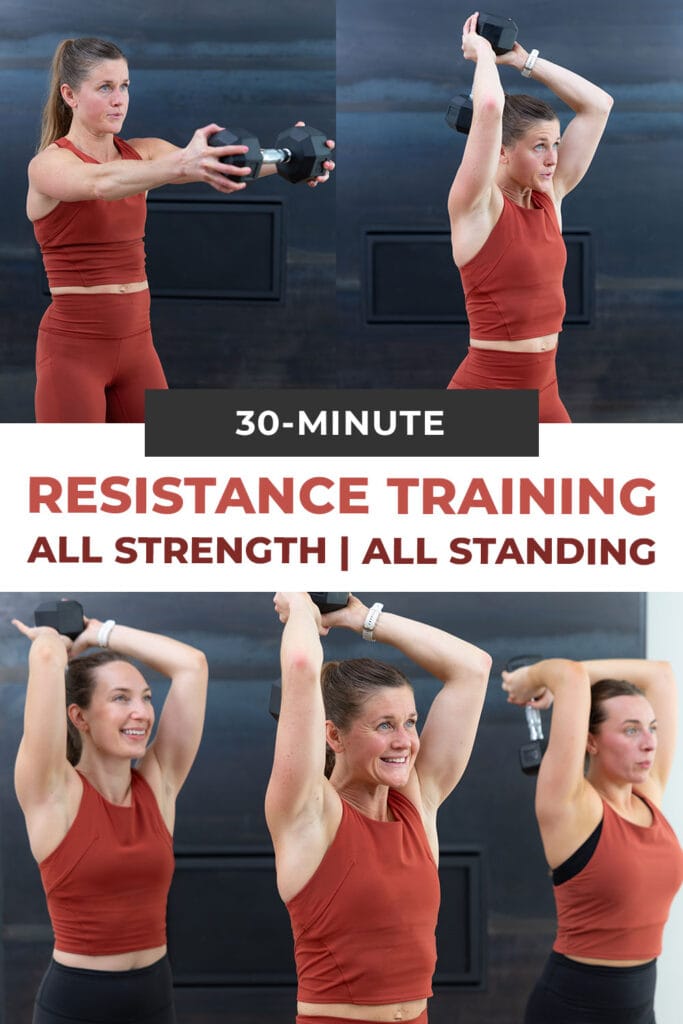
Pork: Versatile Lean Protein
One of my favorite things about cooking with pork is how versatile it is. I love that I can throw a large cut of pork in my slow cooker with neutral seasonings, then use it in a variety of ways (like BBQ sandwiches, nachos and grain bowls) throughout the week.
Pork is an excellent source of protein and provides several important vitamins and minerals. A serving of pork is an excellent source of:
- Protein: a 3-ounce serving of pork loin includes 23 grams of protein.
- Selenium: supports thyroid health.
- Vitamin B-6: supports mood and brain health.
- Zinc: supports tissue repair as well as maintenance of a healthy immune system.
- Beta-alanine: form of amino acid found in pork and a crucial element in muscle development.
How To Shop for Pork:
- Both pork tenderloin and pork sirloin roast meet the criteria for the American Heart Association Heart-Check Mark.
- One of my favorite cuts is pork tenderloin – it is considered “extra lean” and has the same amount of fat as skinless chicken breast.
- Ground pork is also affordable and really versatile – my family loves using it for meatballs and lettuce wraps!
For a wide variety of heart-healthy and family-friendly pork recipes, visit mnpork.com.
Minnesota Pork Board
The Minnesota Pork Board (MPB) administers checkoff programs relating to pork promotion, consumer and producer education and research on behalf of more than 3,000 family pig farms in Minnesota.
This is a sponsored post in partnership with the Minnesota Pork Board. All words and opinions are my own. Thank you for supporting Nourish Move Love, making the content you see on this blog possible.










